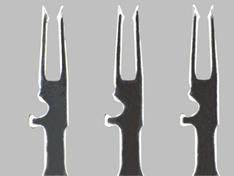Heat treatment related to plating technologies include [1] baking treatment for the purpose of preventing hydrogen brittleness by plating, [2] reflow (remelting) treatment for the purpose of preventing whisker occurrence, and [3] heat treatment to enhance the hardness and wear resistance of plating films. It is advantageous to improve the reliability of plating films and make them more functional.
| Type of plating | Features (characteristic value) | |||||||||||||||||
|---|---|---|---|---|---|---|---|---|---|---|---|---|---|---|---|---|---|---|
| Baking treatment | - Heat treatment conditions to remove hydrogen brittleness (in the case of zinc plating/high-tensile steel materials)
- Heat treatment to improve adhesion properties (in the case of electroless nickel-phosphorus plating)
|
|||||||||||||||||
| Reflow (remelting) treatment | - Melting at a temperature somewhat higher than the melting point (232°C) to reliably remove internal stress for the purpose of preventing whisker occurrence in tin-based plating films. | |||||||||||||||||
| Heat treatment | Heat treatment is performed after plating to enhance the hardness and wear resistance of plating films (mainly amorphous plating).
|
|||||||||||||||||

Reflow treatment of tin plating